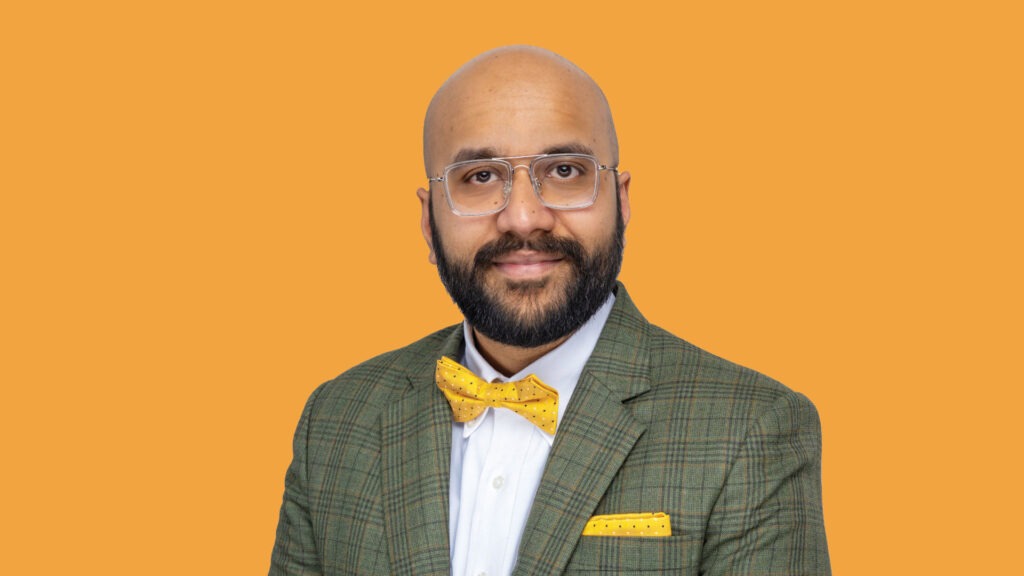It’s not every day that the idea for a new research study gets hashed out over text messages while waiting for an electric car to charge.
But that’s exactly what happened when Yash Babar discovered that his research colleague was killing time at a public Tesla Supercharger station.
“I asked him what he does when he’s there, and he said he usually finds a Starbucks or grabs something to eat,” Babar says. “I thought, somebody should write a paper about this and find out just how much of this business is happening.”
As an assistant professor of operations and information management at WSB, Babar studies the social and economic impacts of technology—especially as it relates to digital platforms and the sharing economy.
“I like to study big questions which matter to people’s lives,” says Babar, who joined WSB in 2020.
As the John and Anne Oros Term Professor, his research explores everything from the impact of ridesharing services on public transportation to how food-delivery platforms change our eating and cooking habits. With a growing number of electric vehicle (EV) charging stations popping up across the country, Babar saw an area ripe for research.
To that end, Babar and his co-author set out to explore how the placement of Tesla Supercharger stations—which promise a full battery charge in under 30 minutes—impacts the volume of consumer foot traffic received by nearby retail establishments.
That’s important, because retailers like big-box stores and supermarkets are increasingly partnering with the automaker to have the stations installed in their parking lots—and with Tesla promising them a business boost, while also covering the installation bill, it’s easy to see why.
“I like to study big questions which matter to people’s lives.”
—Yash Babar
“For retailers, it seems like a win-win,” Babar says. “Part of Tesla’s promise is that by installing the Supercharger, you’ll attract a wealthier customer who probably wouldn’t have otherwise casually walked into your store.”
By analyzing cellular geolocation data and credit card records to assess both range and spending, Babar found merit to Tesla’s claims. Following the installation of a Tesla Supercharger, nearby retail establishments experienced a 4% average increase in monthly visits, with a 5% increase in monthly spending.
Perhaps unsurprisingly, only the businesses closest to the charger received benefits. Nearby retailers had to be less than 150 meters away—or about 500 feet—to experience any spillover traffic, and not every type of retailer benefited equally.
Quick stops like grocery and convenience stores fared better than establishments requiring lengthier visits, like full-service restaurants and department stores.
It’s good news for retailers looking to bring in new revenue streams—but beyond that, Babar says the research also has implications for public policymakers. Through a 2021 federal infrastructure bill, Congress has earmarked billions of dollars to build new EV charging stations, with the Biden administration pushing to have at least 500,000 publicly available chargers by 2030.
With EV companies and charging networks scrambling to take advantage of the money on the table and find new locations for charging stations, Babar hopes the results he’s found can be used to make their placement more equitable.
For instance, if policymakers can present businesses with data that show installing a charger in their parking lot will boost their bottom line, businesses might then agree to help offset the installation and charging costs.
“Then, you can take these precious funds that you have from the federal government and use them to subsidize the placement of an EV charging station elsewhere,” Babar says. “Because if you don’t have a lot of charging stations in neighborhoods where people live, you’re not creating any incentives for them to transition to an EV.”
Going forward, whether it’s his work on EVs or the various case studies he’s developed for his classes, Babar says he continues to show his students the real-world applications of information systems—and the positive impact those applications can create.
“Tech doesn’t have to be just about making money or things like that,” Babar says. “We’re showing students how tech can empower people throughout the world.”
